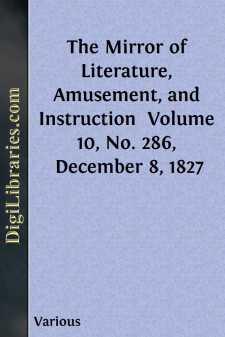Categories
- Antiques & Collectibles 13
- Architecture 36
- Art 48
- Bibles 22
- Biography & Autobiography 813
- Body, Mind & Spirit 142
- Business & Economics 28
- Children's Books 17
- Children's Fiction 14
- Computers 4
- Cooking 94
- Crafts & Hobbies 4
- Drama 346
- Education 46
- Family & Relationships 57
- Fiction 11829
- Games 19
- Gardening 17
- Health & Fitness 34
- History 1377
- House & Home 1
- Humor 147
- Juvenile Fiction 1873
- Juvenile Nonfiction 202
- Language Arts & Disciplines 88
- Law 16
- Literary Collections 686
- Literary Criticism 179
- Mathematics 13
- Medical 41
- Music 40
- Nature 179
- Non-Classifiable 1768
- Performing Arts 7
- Periodicals 1453
- Philosophy 64
- Photography 2
- Poetry 896
- Political Science 203
- Psychology 42
- Reference 154
- Religion 513
- Science 126
- Self-Help 84
- Social Science 81
- Sports & Recreation 34
- Study Aids 3
- Technology & Engineering 59
- Transportation 23
- Travel 463
- True Crime 29
The Mirror of Literature, Amusement, and Instruction Volume 10, No. 286, December 8, 1827
by: Various
Categories:
Description:
Excerpt
To expatiate on the advantages of printing, at this time of day, would be "wasteful and ridiculous excess." We content ourselves with the comparison of Dryden's
"Long trails of light descending down."
In a retrospective glance at our previous volumes (for can the phrenologists tell us of a head capacious enough to contain their exhaustless variety?) our readers will perceive that, from time to time, sundry "accounts" of the origin and progress of printing have been inserted in the MIRROR; and though we are not vain enough to consider our sheet as the "refined gold, the lily, the violet, the ice, or the rainbow," of the poet's perfection, yet in specimens of the general economy of the art, the long-extended patronage of the public gives us an early place.
With an outline of the life of CAXTON our readers must be already familiar; but we wish them to consider the above accurate representation of the FIRST ENGLISH PRINTER'S RESIDENCE as antecedent to a Memoir of Caxton, in which it will be our aim to concentrate, in addition to biographical details, many important facts from the testimony of antiquarians; for scarcely a volume of the Archaeologia has appeared without some valuable communication on Caxton and his times.
In the meantime we proceed with the locale of Caxton's house, situate on the south-west of Westminster Abbey, where was formerly the eleemosynary, or almonry, where the alms of the abbots were distributed. Howell in his Londinopolis, describes this as "the spot where the abbot of Westminster permitted Caxton to set up his press in the Almonry, or Ambry," the former of which names is still retained. This is confirmed by Newcourt, in his Repertorium, who says, "St. Anne's, an old chapel, over against which the Lady Margaret, mother to king Henry VII., erected an alms-house for poor women, which is now turned into lodgings for singing-men of the college. The place wherein this chapel and alms-house stood was called the Eleemosinary, or Almonry, now corruptly called the Ambry, (Aumbry,) for that the alms of the abbey were there distributed to the poor; in which the abbot of Westminster erected the first press for book-printing that was in England, about the year of Christ 1471, and where WILLIAM CAXTON, citizen and mercer of London, who first brought it into England, practised it." Here he printed The Game and Play of the Chesse, said to be the first book that issued from the press in this country.
Hence, according to Mr. M'Creery, the intelligent author of "The Press," a poem, "the title of chapel to the internal regulations of a printing-office originated in Caxton's exercising the profession in one of the chapels in Westminster Abbey, and may be considered as an additional proof, from the antiquity of the custom, of his being the first English printer."
Every lover of science, on approaching this spot, will feel himself on holy ground, however the idle and incurious of our metropolis may neglect the scite, or be ignorant of its identity. We are there led into an eternity of reflection and association of ideas; but lest human pride should be too fondly feasted in the retrospect, the hallowed towers of the abbey, seen in the distance, serve to remind us of the imperial maxim, that "art is long, and life but short."












